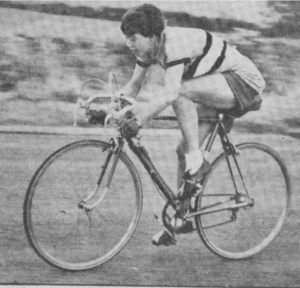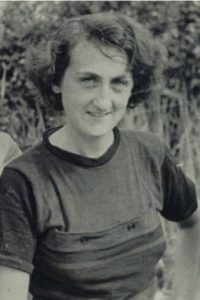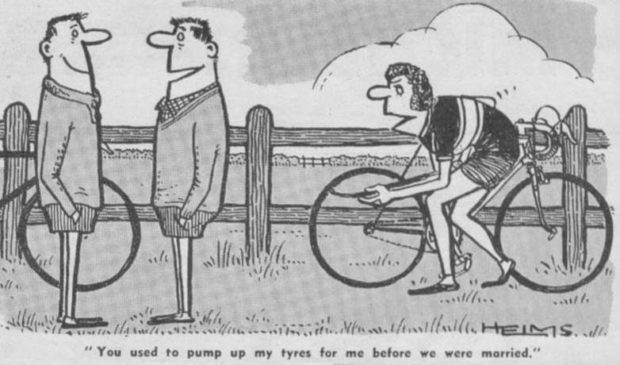The name of the Addiscombe C.C. continued to be found high up in the results whether the events were on track, road or rollers. Events were strictly single sex until the introduction of “mixed racing” in 1970, by which time the number of women competing had gradually diminished. It should be noted that up until about the 1980’s the female cyclist was referred to as “a girl” or “lady” with open events being run for “Ladies”. Eventually the governing bodies endeavoured to equalise matters by referring to “Women”, as males had always ridden events listed for “Men”.
Sixteen year old Christine (Chris) Brooker had been inspired to join the Addiscombe in 1947 after seeing the Addiscombe track girls – Anne Hunnisett, Brenda Tarrant and Pat Cooke – in action at the grass track meeting of a Thornton Heath engineering firm and quickly joined them in achieving success on track, rollers and time trials. By early 1950, Joyce Wawman, Daphne Stratford and Doris Kerry followed suit and they too were soon picking up awards. A good team attracts others to join and over the next few years their numbers and successes built up. A very young Joyce Wawman, riding an evening time trial with the other girls, recorded what was then an excellent “10” time of 25.59, a club record that stood until she made her comeback (as Joyce Smith) in 1970. Tandem riding was still quite popular and two pairs consisting of Daphne Stratford and Pat King (future Mrs Mundy) and Chris Brooker and Joyce Wawman rode the South West London Ladies 30 on the Amersham course to good effect, gaining third fastest and team.
Daphne Stratford scored eleven placings in 1951, from a win in the West Kent RC 10 to 2nd fastest in the Twickenham 100 as well as breaking three club records. Doris Kerry decided to tackle the Rosslyn Ladies 12 hours and finished 3rd with 216 miles. In the south east, team wins at the shorter distances were also beginning to come their way and quite a few handicap awards. Chris Brooker and Joyce Wawman repeated their third placing in the S.W. London Ladies tandem 30. At the end of the season, encouraged by the indefatigable Charlie Davey, Brooker and Stratford made a successful attempt on the Women’s Road Records Association 50 miles tandem record. The course ran west to east along the A40/A418 and despite a front wheel puncture when negotiating a roundabout on the Oxford by-pass they knocked 1 minute 25 seconds off the previous best.
With Eileen Cullen, Eileen Newman and Vicky Barber joining the club more team successes followed in 1952 mainly led by Daphne Stratford. Stratford started off the season with wins in the 29th Wheelers 10, Kent C.A. 25 and Southern Clarion 25, placed fifth in the National Championship 25 and an even better third to take the bronze medal in the Championship 100.

With the interest in women’s racing, full fields of 100 female competitors were not unknown in time trials and the Southern Road Records Association set women’s standards for their recognised record distances/routes. In 1951 Daphne Stratford (pictured) was the first to establish an SRRA record with her time of 2.19.18 for 50 miles. She was to follow this up two years later with a successful attack on the London to Hastings and Back, a hilly route that she covered in 5.57.06, and the WRRA London to Portsmouth and Back in 7.18.25. Chris Brooker too, set an SRRA record for 100 miles and bettered the London to Worthing and Back.
Daphne Stratford finished third in the Kent C.A. Best All-Rounder competition and headed the girls to take the Kent C.A. BAR team. In the RTTC’s National Best All-Rounder competition, Stratford finished 7th, Chris Brooker 19th and with Doris Kerry they were runners-up to the girls of the Apollo Cycling Club, a rival Croydon club. Kerry rode the Rosslyn 12 again but a late start cost her a placing.

When Claud Perry took a teaching job in the South East, his wife Betty decided they should join the Addiscombe having shared “digs” with the Addiscombe girls at the previous year’s Championship 25 in Somerset. Formerly with Plymouth Corinthians, the West Country’s loss was definitely Addiscombe’s gain and Betty became a strong member of the team. Yet despite the added strength team wins at first became near-misses. On holiday in South Wales, Daphne Stratford and Chris Brooker rode the Byways 25 and both, in turn, broke the previous Welsh Competition Record, although it fell yet again to the ultimate event winner. Brooker rode the Rosslyn 100, taking 3rd fastest and 3rd handicap but it was the 1953 RTTC Championship 100 that became a story that still runs. Daisy Stockwell, Apollo C.C. and defending National Champion starting last, had ridden through the back of the field, including past Brooker who had started 15 minutes ahead of her. The last five miles saw Brooker close back to Stockwell who was going through a bad patch but Stockwell was not finished off yet, certainly not by another Croydon girl! The two of them, the last on the road of their respective teams, battled along the A4 Bath Road and up Pangbourne Lane.
When Chris Brooker crossed the finishing line fractionally ahead of Daisy Stockwell, the Addiscombe, backed by consistent rides from Daphne Stratford and Eileen Cullen, had broken the old Competition Team record standing to the Apollo girls. A wheel later and the result board showed that the Apollo had taken back their record, okay, admittedly by a thumping 36 mins 40 secs! Well done Apollo, but the RTTC accepted the Addiscombe had broken the record and it is shown in their archives as the national record held for the shortest time in cycling – possibly in any sport.

At the end of July 1953 Daphne attacked the London to Portsmouth and Back record held by Stella Farrell of the Yiewsley R.C. Starting at Esher at 1.30 a.m. (yes, this is not a printing error), a policeman stops by to make sure everything is okay, then she is off to her first turn in London before heading for Portsmouth where she has to weave through the workers on their way to the dockyard. On turning for home, she briefly stops “to take off her cardigan” and is told she is on schedule. Her last drink is handed up in Ripley and shortly after a policeman joins the following vehicles, containing the timekeeper, an observer, and the feeding crew. Nearing Esher the police officer speeds ahead to hold up traffic and see her safely through (such was record breaking in the 1950’s) and Daphne Stratford has set a new record, 16.5 minutes faster than Farrell.
Inspired by Doris Kerry, the girls finished off the 1953 season that year by riding the Rosslyn 12 and taking the team award, Chris Brooker finishing just 0.24 miles ahead of Daphne Straford with Kerry not far behind. In the RTTC Best All-Rounder team competition they again finished runners-up to the Apollo. Rivalry within the club was keen and Stratford lost the Ladies’ Club Championship by a mere .004 mph to Betty Perry

The women’s total of team victories for the year 1954 commenced with their third successive victory in the Southern Clarion 25 and for the first time included National honours. The South Eastern RC would be promoting the 50 miles National Championship on local roads and having been “knocking on the door” for two years the women were determined that this was their year. Daphne Grist (nee Stratford) finished in 10th position and closely backed up by Betty Perry and Chris Watts (nee Brooker) led the team to victory. This victory augured well for the National Championship 100 to be held north of York. The women were staying in separate “digs” to their male helpers. Fortunately, the men went round in the morning to pick them up only to find with 40 minutes to first off our women had not been called and were still asleep! With a makeshift breakfast in hand and a promise of a drink down the road it was a mad dash to the start. Poor marshalling resulted in Doris Kerry going off course and although riding well she lost 20 minutes and was forced to pack. Perhaps to the Addiscombe’s advantage, a member of an opposing team also went off course. Despite a puncture, conveniently near an Addiscombe feeding station, Watts was our fastest with 4.51.46 in 6th position and with Grist and Perry they took their second Championship Team win of the year. Their individual counting rides over 25, 50 and 100 miles were also sufficient to give them the National Best All-Rounder Team title for 1954.
Doris Kerry, Daphne Grist and Chris Watts rounded off that year with the Rosslyn 12 hours event. Watts ran out the overall winner with 237.9 miles, a new National Competition Record, a quarter of a mile improvement on the previous best set by Eileen Sheridan. The one and only Beryl Burton was just dabbling in time trials that year and it would be 5 years before she first smashed “the 12” with her ride of 250.37, to be followed eight years later by her stupendous ride of 277.25. In 1954 Watts’ ride was a new National Competition Record and backed by Grist in 3rd position with 223.84 miles and Kerry, they set a new Team Competition Record of 675.10 miles, 37.28 miles better than the old record and one that was to stand for 28 years.
The 1955 season had started well for the women with Jean Burgess joining the club. In her first season Burgess managed to take no less than seven handicap awards and featured in six of the eight team wins the women achieved.
The women’s major successes were in retaining both the 50- and 100-miles National Team Championships although they just lost out to the Southampton Wheelers for the BBAR Team. In the 50 Championship Daphne Grist was highest placed at 7th, and was joined by Chris Watts and Eileen Cullen for the team. The 100 Championship saw Watts lose the bronze medal position by just 16 seconds to finish 4th in 4.49.36 with Burgess 4.53.16 and Grist 4.54.12 making up the team.

The Club took on the promotion of an Open 50 miles time trial for the Ladies in 1955, an event that ran for nine years. The entry of thirty was considered poor with not one Addiscombe starter. Daisy Franks, Apollo C. C., was the first to put her name on the new trophy with a ride of 2.16.53.

It was a miserably wet August morning in 1956 when the women got their third consecutive team win in the National Championship 100. On this occasion Jean Burgess was fastest with 4.51.17, Daphne Grist 4.52.24 and Chris Watts 4.52.33. It was the fact that the club had several women competing in time trials; all of similar capability, and vying with each other, that helped them to so many team wins over this period. Their chance of retaining the Championship 50 title had disappeared the previous month when Jean punctured and retired, and despite running the Silchester girls close in the Women’s Best All-Rounder table the Addiscombe women again failed to re-capture the All-Rounder Team medals.
The Women’s RRA London to Brighton and back tandem record fell to Chris Watts and Daphne Grist in 1956 with a fine ride of 4.36.06. The pair started at Crawley, proceeded north to turn first at Hyde Park Corner, back south to the Aquarium roundabout at Brighton and north again to finish at their starting point with the old Handcross Hill to climb in the last three miles. They completed their season with a successful attempt on the Women’s RRA 100 miles tandem record, 3.57.11, improving their own 50 miles record en route to 1.55.34.

Attacking RRA records before the growth of motor traffic was vastly different from anything riders fifty years hence would have to experience. The London to Brighton road was a chosen route for numerous activities, from the annual veteran car runs and athletic events, to bed and pram pushing! These were the days when the police authorities were also willing to lend support whenever they could. For the Brighton and Back record attempt the Addiscombe girls made a pre-attempt visit to each of the police stations en route, had a friendly chat with the duty officer and left a schedule of the planned attempt, then it was fingers-crossed for the day itself. On reaching the first major crossroads at Purley imagine their horror to find the traffic lights at red and a policeman standing in the middle of the junction. As they attempted to slow the officer frantically waved them onwards – and so it was all the way to Hyde Park Corner and back again. At the girls approach to each major junction the police set all lights to red to stop other traffic moving. Officers also held back traffic on the southbound route of the one-way systems at Vauxhall and Westminster so the girls could take the most direct line to Hyde Park. This was an enormous help to Watts and Grist but the effort of pushing the pedals round was still theirs!
Chris Watts scored her second win of the Rosslyn Ladies’ 12-hour in 1956 finishing with 223.79 miles on a particularly rough September day that had started with 3.5 hours of continuous rain.

Betty Perry and Eileen Gunner (nee Newman) returned to ride a few local time trials with Chris Watts in 1957. To end the year, following what had been for her a mediocre season, Watts, again the club’s only entrant in the Rosslyn 12, pulled off her third win with 229.48 miles to win outright a massive silver trophy.
The Addiscombe Women’s Open 50 yet again received very poor support, only 15 entrants, and was won by Jean Terry, Feltham R.C., in 2.23.18.
- An Introduction to our History
- The 1883 Addiscombe Cycling Club
- The 1906 Addiscombe Cycling Club
- An Historical Background to the Road Record Associations
- A Brief Historical Background to Cycling Time Trials
- The Club’s Revival, 1929 to 1939
- The Club in Wartime, 1940 to 1946
- The Post-War Years, 1947 to 1957
- Post-War Track and Roller Racing
- The Men in Post-War Time Trials
- The Women in Post-War Time Trials
- Post-War Closed Circuit and Road Racing
- An Influx of New Riders and the Passing of a Statesman, 1958 to 1964
- The Club Heads Towards its Golden Jubilee, 1965 to 1978
- Membership Declines, 1979 to 1987
- The Arrival of the Young Mountain Bikers, 1988 to 1994
- Another Period of Declining Membership, 1995 to 1999
- New Century and a New Look for the Addiscombe, 2000 to 2006





